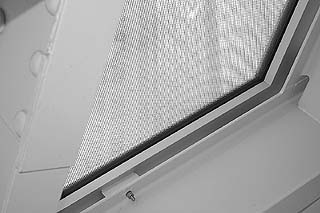
DJC.COM
May 20, 2004
Divining the cost of an oddball building
David Langdon Adamson

Photo by Jon Silver
Aluminum mesh enclosed in the windows of the central library saves energy by screening out the sun’s heat, but it made cost estimation more difficult. |
The role of the cost estimator in any construction project is to help the owner understand and manage project costs and remain within budget.
In most cases, cost consultants provide this service by helping the owner establish a realistic budget and by providing estimates for the total cost of construction at the end of each design phase.
From the start of the Seattle Central Library project, however, the estimating team faced a number of challenges. The design incorporated a number of unconventional materials and ideas, including the building's unique shape, skin and mechanical systems.
The shape of the building was extremely difficult to translate from two dimensions (on paper) into three, making it tough to calculate the cost of the structure and external skin.
Additionally, the unique design required temporary structures to be built to support the building during the construction process, a feature that increased the project cost.
Price of uniqueness
Determining the cost of the building exterior was another interesting challenge. Buildings with an outer skin of glass often suffer from extreme heat gain due to the sun streaming in (and thus require considerably more energy in order to cool the interior and counteract the extra heat).
To avoid this problem the design called for the glass to be combined with a fine mesh of semi-opaque screening material that prevents heat gain into the building — a unique design strategy that allowed the building to save energy on cooling, but presented a distinct challenge when attempting to establish costs.
The location of the mechanical systems for the building also presented quite a challenge. Instead of housing these systems in a mechanical room on the roof, as is often the case, the systems were instead either stacked vertically around the perimeter, or in some cases, incorporated into the skin of the building.
Additionally, different mechanical systems were used on different floors. Each of these had to be taken into account when establishing reliable costing information for the project.
Continual value engineering
The challenges due to the design and materials for this project meant the cost estimators were required to take on a more interactive role, working closely with the designers and integrating cost with design at every step of the process.
From the earliest concept of the building it was clear that in order to stay on budget the project had to remain open to new alternatives. This type of continual value engineering required the full attention of everyone involved in the project.
Coordinating efforts across all teams was both challenging and rewarding. The cost estimators, located in Seattle, had to work closely with designers who were in the Netherlands. Each new and innovative design approach required careful study in order to understand the costs involved, setting up a continual give-and-take between the two teams.
The complexity of the building, due to its structure, materials and mechanical systems, was never underestimated. Each of these pieces required significant coordination between the designers and cost estimators to understand how the systems worked and fit together.
This integrated approach allowed both the designers and cost estimators to determine the most effective plan for the building in terms of value, vision and cost.
The inclusion of the general contractor on the project team was a valuable addition and completely appropriate for such a complex building.
The general contractor was able to provide valuable input on logistics and constructability factors that would inevitably influence the cost, as well as conduct parallel estimating activities with the cost estimating team to provide further cost certainty.
That input allowed the team to shape the cost plan appropriately, ensuring that the project remained consistently on budget throughout the process, mitigating any budgetary risks.
Throughout the design phase, the project team's collaborative, team-spirit approach played a significant role in successful cost management for the project.
David Hudd is an associate principal at David Langdon Adamson. For 30 years the firm has been developing project budgets, monitoring costs and schedules, and providing life-cycle cost analyses, operations and maintenance budgets.
Other Stories:
- Do we really need libraries anymore?
- College libraries cater to widening needs
- Living rooms for urban neighborhoods
- Dozens of library projects on tap for Seattle, King County
- Libraries: the next must-have amenity
- Library's tech system is also daring and elegant
- Intuitive design yields unlikely results
- Nuts and bolts shape the library's unique design
- Neighborhood libraries get big-city treatment
- Library lights lift a heavy load
Copyright ©2009 Seattle Daily Journal and DJC.COM.
Comments? Questions? Contact us.